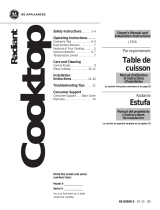
231-2001161 Rev. 1
Installation Instructions
IMPORTANT SAFETY INSTRUCTIONS
FOR YOUR SAFETY
•For Personal Safety, remove house fuse or open
circuit breaker before beginning installation. Failure to
do so could result in serious injury or death.
• Be sure your cooktop is installed properly by a
qualified installer or service technician.
• To eliminate the risk of burns or fire due to reaching
over heated surface elements, cabinet storage
located above the surface units should be avoided. If
cabinet storage space is to be provided, the risk can
be reduced by installing a range hood that projects
horizontally a minimum of 5" beyond the bottom of the
cabinets. Cabinet installation above the cooktop may
be no deeper than 13".
• Make sure the cabinets and wall coverings around the
cooktop can withstand the temperatures (up to 200°F)
generated by the cooktop.
• The cooktop should be easy to reach and lighted with
natural light during the day.
• Always disconnect the electrical service to the cooktop
before repairing or servicing the cooktop. This can
be done by disconnecting the fuse or circuit breaker.
Failure to do this could result in a dangerous or fatal
shock. Know where your main disconnect switch is
located. If you do not know, have your electrician
show you.
ELECTRICAL REQUIREMENTS
This appliance must be supplied with the proper voltage
and frequency, and connected to an individual, properly
grounded branch circuit, protected by a circuit breaker or a
time delay fuse as noted on name plate and the chart below.
We recommend you have the electrical wiring and hookup
of your cooktop connected by a qualified electrician. After
installation, have the electrician show you where your main
cooktop disconnect is located.
Wiring must conform to National Electrical Code. You can
get a copy of the National Electrical Code, ANSI/NFPA No.
70-Latest Edition, by writing to:
National Fire Protection Association
Batterymarch Park
Quincy, MA 02269
In Canada, wiring must conform to Canadian Electrical
Code (CEC).
The cooktop conduit wiring is approved for copper wire
connection only, and if you have aluminum house wiring,
you must use special UL approved connectors for joining
copper to aluminum. In Canada, you must use special
CSA approved connectors for joining copper to aluminum.
Installations with Aluminum House Wiring require attention.
See Warning under
NOTES: ALUMINUM WIRING,
above
.
You must use a two-wire, three conductor 208/240 VAC, 60
Hertz electrical system. A white (neutral) wire is not needed
for this unit. The cooktop must be installed in a circuit that
does not exceed 125 VAC
nominal to ground.
Refer to the name plate on
your cooktop for the KW
rating for your cooktop.
Name plate location
KW Rating 240v KW Rating 208V
Recommended
Circuit Size
(Dedicated)
20 Amp
4.9 KW - 7.2 KW 4.2 KW - 6.2 KW 30 Amp
7.3 KW - 9.6 KW 6.3 KW - 8.3 KW 40 Amp
9.7 KW - 12.0 KW 8.4 KW - 10.4 KW 50 Amp
NOTE TO ELECTRICIAN: The power leads supplied
with this appliance are UL recognized for connections
to larger gauge household wiring. The insulation of
these leads is rated at temperatures much higher
than the temperature rating of household wiring. The
current carrying capacity of a conductor is governed
by the wire gauge and also the temperature rating of
the insulation around the wire.
NOTE: ALUMINUM WIRING
INSTALLATIONS WITH ALUMINUM
HOUSE WIRING REQUIRE ATTENTION:
A. Improper connection of Aluminum house wiring
to appliance copper leads can result in an
electrical hazard or fire. Use only connectors
designed for joining copper to aluminum and
follow the manufacturer’s recommend procedure
closely.
B. Aluminum to Copper wiring connections must
conform with the National Electrical code, local
codes and industry-accepted wiring practices.
C. If an anti-oxidant compound is added to the
wiring connectors, the compound should be
UL-Listed and suitable for the application
materials, voltage and temperature.
D. Connectors for joining Aluminum and Copper
wiring may be larger in size than standard
connectors. It is recommended to use a double-
gang, or larger, electrical box to enclose the
connectors joining Aluminum and Copper wiring.









